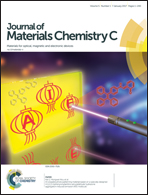Homoleptic thiazole-based IrIII phosphorescent complexes for achieving both high EL efficiencies and an optimized trade-off among the key parameters of solution-processed WOLEDs†
Abstract
Two homoleptic thiazole-based IrIII phosphorescent emitters, Ir-3Tz1F and Ir-3Tz2F, with fluorinated 2-phenylthiazole-type ligands were designed and prepared. Their thermal stability, and photophysical and electrochemical properties, as well as electroluminescent (EL) performances in both monochromic OLEDs and solution-processed WOLEDs were investigated. When doped in monochromic OLEDs made by vacuum deposition, Ir-3Tz1F gave the maximum EL efficiencies with ηL of 56.2 cd A−1, ηext of 15.8% and ηp of 50.2 lm W−1. Critically, solution-processed WOLEDs based on Ir-3Tz1F with three primary colors could achieve an excellent trade-off among the stable balanced white EL spectra, a high EL efficiency and a high color rendering index (CRI). The optimized solution-processed WOLED exhibited very attractive EL efficiencies of 33.4 cd A−1, 16.5% and 30.6 lm W−1, while maintaining both a high CRI of ca. 80 and very stable Commission Internationale de L’Eclairage (CIE) coordinates in a wide driving voltage range from 4 V to 11 V.


 Please wait while we load your content...
Please wait while we load your content...